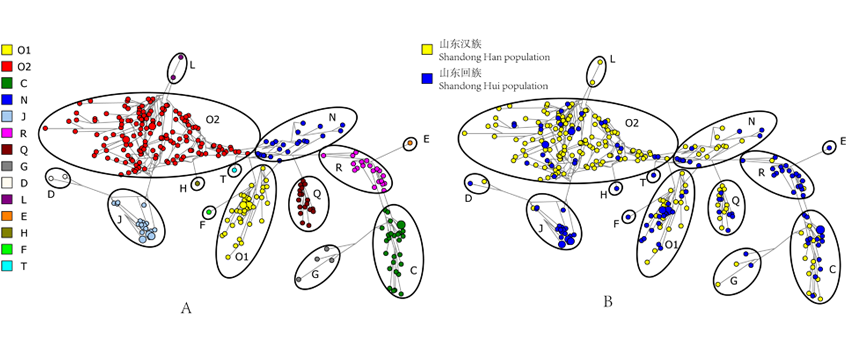

Paternal genetic structure of Han and Hui male populations in Shandong
Received date: 2020-06-05
Online published: 2021-04-09
This study is based on 75 Y-SNPs and 23 Y-STRs to analyze the paternal genetic structure of Shandong Han and Hui males and provides basic data for forensic application and population genetics. Mini-sequencing was used to type 75 Y-SNPs of 187 individuals of Han and 130 individuals of Hui. The PowerPlex®Y23 kit was used to type 23 Y-STRs of all individuals. Allele frequency, haplotype frequency and haplogroup frequency were calculated by direct counting. Gene diversity, haplotype diversity and haplogroup diversity were calculated according to the formula D=n(1-∑pi2)/(n-1). The median-joining networks were constructed using NETWORK 5.0 and NETWORK Publisher. The research results showed that haplogroup O-M175, C-M130, N-M231, Q-M242 were the major haplogroups of the Han population, and haplogroup O-M175, J-M304, R-M207, C-M130, N-M231 were the major haplogroups of Hui population. 187 haplotypes were detected in Han populations based on twenty-three Y-STR loci, and the haplotype diversity was 1.000. And 121 haplotypes were detected in Hui populations, the haplotype diversity was 0.9988. The Networks showed that the individuals of same haplogroup were relatively independently clustered. There were shared haplogroups between Han and Hui populations, as well as some population specific haplogroups. For example, haplogroups J-M304 and R-M207 were prevalent in Hui population, while haplogroup Q-M242 was prevalent in Han population. The major haplogroup of both populations was haplogroup O-M175. Haplogroups J-M304 and R-M207 were distributed at high frequencies in Shandong Hui male population, and haplogroups Q-M242 were distributed at high frequencies in the Shandong Han male population. A certain percentage of unique Y chromosome haplotypes in western Eurasia and the Middle East were retained among the Shandong Hui male population.

Key words: Forensic genetics; Y haplogroups; Y-SNPs; Y-STRs; Shandong populations
Jinke ZHANG , Wei DONG , Guangfeng TANG , Xiaoliang HUANG , Zhen YANG , Xiaojun WANG , Jie ZHANG , Yingjian ZHAO , Yiqing ZHU , Li JIANG . Paternal genetic structure of Han and Hui male populations in Shandong[J]. Acta Anthropologica Sinica, 2022 , 41(01) : 65 -72 . DOI: 10.16359/j.1000-3193/AAS.2021.0007
| [1] | 中华人民共和国2010年人口普查数据[DB/OL].URL: http://www.stats.gov.cn/tjsj/pcsj/rkpc/6rp/indexch.htm, 2010 |
| [2] | 陈连开. 中国民族史纲要[M]. 北京: 中国财政经济出版社, 1999 |
| [3] | 程有为, 吴少珉. 论魏晋南北朝时期中原地区的民族问题[J]. 许昌学院学报, 1996(1): 15-20 |
| [4] | 周郢. 泰安回族士人与泰山文化[J]. 中国穆斯林, 2014(2): 60-63 |
| [5] | 金坡. 泰安芝田村清真寺考略[J]. 泰山学院学报, 2010, 32(4): 22-27 |
| [6] | 山东省志,第78卷,少数民族志[M]. 济南: 山东人民出版社, 1998 |
| [7] | Jobling MA. The human Y chromosome: an evolutionary marker comes of age[J]. Nature Reviews Genetics, 2003, 4(8): 598-612 |
| [8] | Butler JM. Recent Developments in Y-Short Tandem Repeat and Y-Single Nucleotide Polymorphism Analysis[J]. Forensic Science Review, 2002, 15(2): 91-111 |
| [9] | Jobling MA, Tyler-Smith C. Fathers and sons: the Y chromosome and human evolution[J]. Trends in Genetics, 1995, 11(11): 449-456 |
| [10] | Underhill PA, Shen P, Lin AA, et al. Y chromosome sequence variation and the history of human populations[J]. Nature Genetics, 2000, 26(3): 358-361 |
| [11] | 侯一平. 法医物证学(第4版)[M]. 北京: 人民卫生出版社, 2016 |
| [12] | 文波. Y染色体、mtDNA多态性与东亚人群的遗传结构[D]. 上海:复旦大学, 2004 |
| [13] | Nei M, Tajima F. DNA Polymorphism Detectable by Restriction Endonucleases[J]. Genetics, 1981, 97(1): 145-163 |
| [14] | Bandelt HJ, Forster P, Rohl A. Median-joining networks for inferring intraspecific phylogenies[J]. Molecular Biology and Evolution, 1999, 16(1): 37-48 |
| [15] | Olofsson JK, Mogensen HS, Buchard A, et al. Forensic and population genetic analyses of Danes, Greenlanders and Somalis typed with the Yfiler Plus PCR amplification kit[J]. Forensic Science International Genetics, 2015, 16: 232-236 |
| [16] | Ullah I, Olofsson JK, Margaryan A, et al. High Y-chromosomal Differentiation Among Ethnic Groups of Dir and Swat Districts, Pakistan[J]. Annals of Human Genetics, 2017, 81(6): 234-248 |
| [17] | Ferri G, Robino C, Alù M, et al. Molecular characterisation and population genetics of the DYS458.2 allelic variant[J]. Forensic Science International: Genetics Supplement Series, 2008, 1(1): 203-205 |
| [18] | Xie MK, Song F, Li JN, et al. Genetic substructure and forensic characteristics of Chinese Hui populations using 157 Y-SNPs and 27 Y-STRs[J]. Forensic Science International: Genetics, 2019, 41: 11-18 |
| [19] | Zhong H, Shi H, Qi XB, et al. Extended Y chromosome investigation suggests postglacial migrations of modern humans into East Asia via the northern route[J]. Molecular Biology and Evolution, 2011, 28(1): 717-727 |
| [20] | Zhang XM, Kampuansai J, Qi XB, et al. An updated phylogeny of the human Y-chromosome lineage O2aM95 with novel SNPs[J]. PLoS One, 2014, 9(6): e101020 |
| [21] | Malhi RS, Gonzalez-Oliver A, Schroeder KB, et al. Distribution of Y chromosomes among native North Americans: a study of Athapaskan population history[J]. American Journal of Physical Anthropology, 2010, 137(4): 412-424 |
| [22] | Dulik MC, Owings AC, Gaieski JB, et al. Y-chromosome analysis reveals genetic divergence and new founding native lineages in Athapaskan- and Eskimoan-speaking populations[J]. Proc Natl Acad Sci USA, 2012, 109(22): 8471-8476 |
| [23] | Sun N, Ma PC, Yan S, et al. Phylogeography of Y-chromosome haplogroup Q1a1a-M120, a paternal lineage connecting populations in Siberia and East Asia[J]. Annals of Human Biology, 2019: 1-18 |
| [24] | Hong WG, Chen SW, Shao HW, et al. HLA class I polymorphism in Mongolian and Hui ethnic groups from Northern China, Hum[J]. Immunol. 2007, 68(5): 439-448 |
| [25] | Gladney DC. Ethnic identity in China: the making of a Muslim minority nationality[M]. Fort Worth: Harcourt Brace College Publishers, 1998, 159-176 |
| [26] | 王传超. 东亚人群遗传历史[D]. 上海:复旦大学. 2015 |
| [27] | Tu J, Yip VF, Du R. Ethnic Groups in China[M]. New York: Science Press, 1993 |
| [28] | 王钟翰. 中国民族史[M]. 北京: 中国社会科学出版社, 1994 |
| [29] | 董薇, 张金科, 黄晓亮, 等. 基于27重SNP族群推断体系研究泰安汉、回族遗传结构[J]. 刑事技术, 2020, 45(4): 348-353 |
/
| 〈 |
|
〉 |